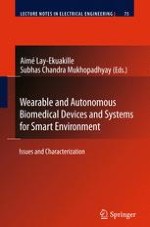This book is dedicated to wearable and autonomous systems, including devices, offers to variety of users, namely, master degree students, researchers and practitioners, An opportunity of a dedicated and a deep approach in order to improve their knowledge in this specific field. The book draws the attention about interesting aspects, as for instance, advanced wearable sensors for enabling applications, solutions for arthritic patients in their limited and conditioned movements, wearable gate analysis, energy harvesting, physiological parameter monitoring, communication, pathology detection , etc..
